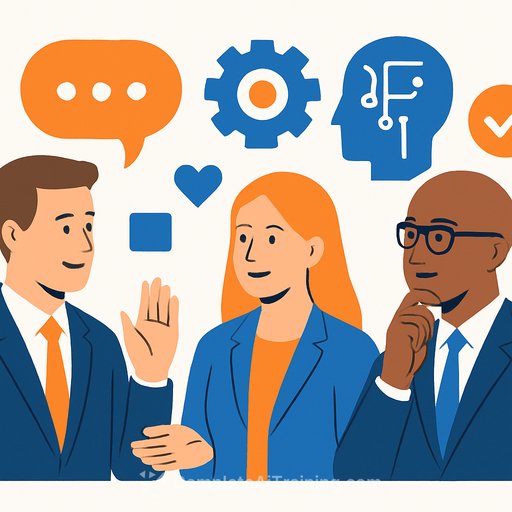AI progress is shrinking headcounts. Here's what HR needs to do now
Across North America, layoffs and hiring freezes are picking up as leaders bet they can grow output without growing headcount. In Canada, TD Bank is reducing its workforce by about two per cent across direct investing, risk management, and corporate functions. Scotiabank is cutting roles in Canadian banking, and Air Canada has let go of middle managers to streamline operations.
In the U.S., Amazon is preparing to cut tens of thousands of corporate roles, Target is trimming about eight per cent of corporate positions, and firms like JPMorgan Chase and Walmart plan to keep headcount flat while sales rise. The common thread: AI and automation are expected to lift productivity enough to justify fewer replacements and fewer new hires.
What's driving the cuts
AI is being embedded into workflows that used to rely on people-especially finance, legal, customer support, and back-office functions. Leaders see a path to higher output per employee and are pausing backfills while they retool processes. For HR, that means two parallel tracks: reduce with care, and rebuild skills for what's next.
Immediate priorities for HR
- Strategic workforce planning: Map roles by exposure to automation. Label them "AI-competing" (task-heavy, repeatable) vs. "AI-augmenting" (judgment, relationship, cross-functional). Build a heatmap of risk, timeline, and action: reduce, redeploy, reskill, or hire.
- Change management and communication: Explain the business case, the timeline, and what support employees will receive. Set clear expectations for how AI will change day-to-day work and how success will be measured.
- Legal and ethical guardrails: Follow employment standards, notice periods, and union agreements. Document objective selection criteria and keep audit trails for decisions and AI usage policies. Work with counsel to avoid missteps.
- Employee support and brand protection: Offer severance, outplacement, and mental health resources. Fund targeted reskilling and make internal moves the default for at-risk talent.
- Build future-ready talent: Teach people to use AI to improve their output and judgment, not just click buttons. The more employees can use AI to strengthen their work, the more future-proof their jobs become.
A simple role heatmap (use this structure)
- Classify tasks: transactional processing, routine analysis, document drafting, customer inquiry handling, quality checks, compliance reviews.
- Rate exposure: High (rule-based, repeatable), Medium (pattern-based with oversight), Low (judgment-heavy, stakeholder-driven).
- Decide actions: Reduce via attrition/backfill holds, Reskill to AI-augmented workflows, Redeploy to higher-value work, Hire selectively for AI fluency.
- Set 90-day metrics: output per FTE, cycle time, error rate, % of roles with AI-enabled SOPs, AI adoption rate by team.
Communication playbook for a shaky quarter
- Timeline: Day 0 leadership note with rationale and supports; Day 1 manager toolkits; Day 2 team Q&A; weekly progress updates for 4-6 weeks.
- Message to affected employees: what's changing, why now, selection criteria, severance/outplacement details, timelines, and a single point of contact.
- Message to remaining teams: business goals, how AI changes the work, training plan, performance expectations, and how success will be recognized.
- Manager enablement: talking points, FAQ, 1:1 scripts, and guidance on handling tough questions without speculation.
Legal and risk checklist (Canada + U.S.)
- Confirm employment standards, notice, and severance by jurisdiction; address mass termination thresholds.
- Review union agreements and consultation obligations; document required notices.
- In the U.S., validate WARN Act applicability and timing; in Canada, align with provincial rules for group terminations.
- Ensure AI-related monitoring and productivity tracking follow privacy laws and internal policy.
- Keep written, objective selection criteria and validation to reduce bias and wrongful dismissal risk.
Support people, protect the brand
- Outplacement + alumni: resume help, interview prep, curated job leads, and an alumni community to maintain goodwill.
- Learning stipends: fund AI, data, and domain training tied to internal roles or market demand.
- Mental health: EAP access, manager training to spot distress, and workload adjustments during transition.
- Internal mobility: fast-track transfers for at-risk employees into AI-augmented roles with clear training paths.
Build AI fluency that sticks
The Conference Board of Canada points to a simple truth: the more employees use AI to improve their work, the safer their roles become. Focus training on use cases tied to business outcomes, not just tool tours.
- AI literacy for all: prompts, verification, data privacy, and judgment.
- Role-based practice: finance close reviews, contract markup, customer inquiry triage, QA checks.
- Team-level SOPs: where AI fits in the workflow, how outputs are checked, and who signs off.
- Metrics: time-to-competence, error reduction, and uplift in throughput.
The Conference Board of Canada
What leaders are saying
"AI and trying to understand how we use it to benefit the business is consuming companies' attention. It's not a static situation. It's constantly evolving. The challenge and opportunity with the speed at which AI evolves means there's always something new. It's continually getting better, but then on the other side of that, it makes it difficult to try and bring your teams up to speed like you would in a traditional way." - Erin Gordon, VP Human Resources, Lindt & Sprüngli Canada
Quick metrics to review weekly
- Backfill hold rate and time-to-backfill for critical roles.
- Internal mobility moves from at-risk roles to AI-augmented roles.
- % of roles with documented AI-enabled SOPs.
- AI adoption and output per FTE by team.
- Employee sentiment on AI (pulse scores) and regrettable attrition.
Where to upskill fast
If you need structured, role-specific AI training for HR, finance, and operations teams, explore these resources:
Bottom line
Leaders are betting AI will lift productivity with smaller teams. HR's edge is clear plans: reduce with care, communicate with precision, stay inside the lines legally, support people through change, and upskill the organization for AI-augmented work. Execute those five, and you'll protect both results and reputation.
Your membership also unlocks:






